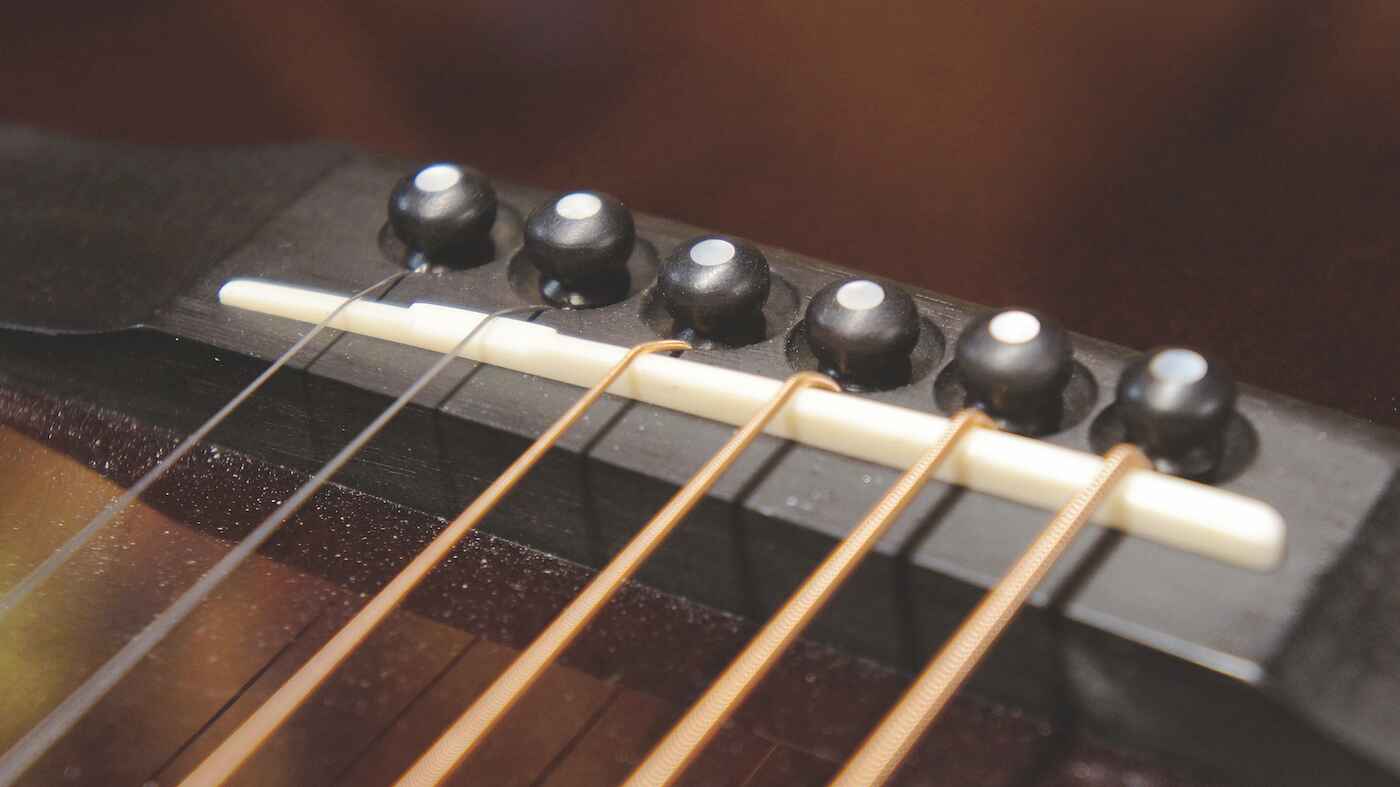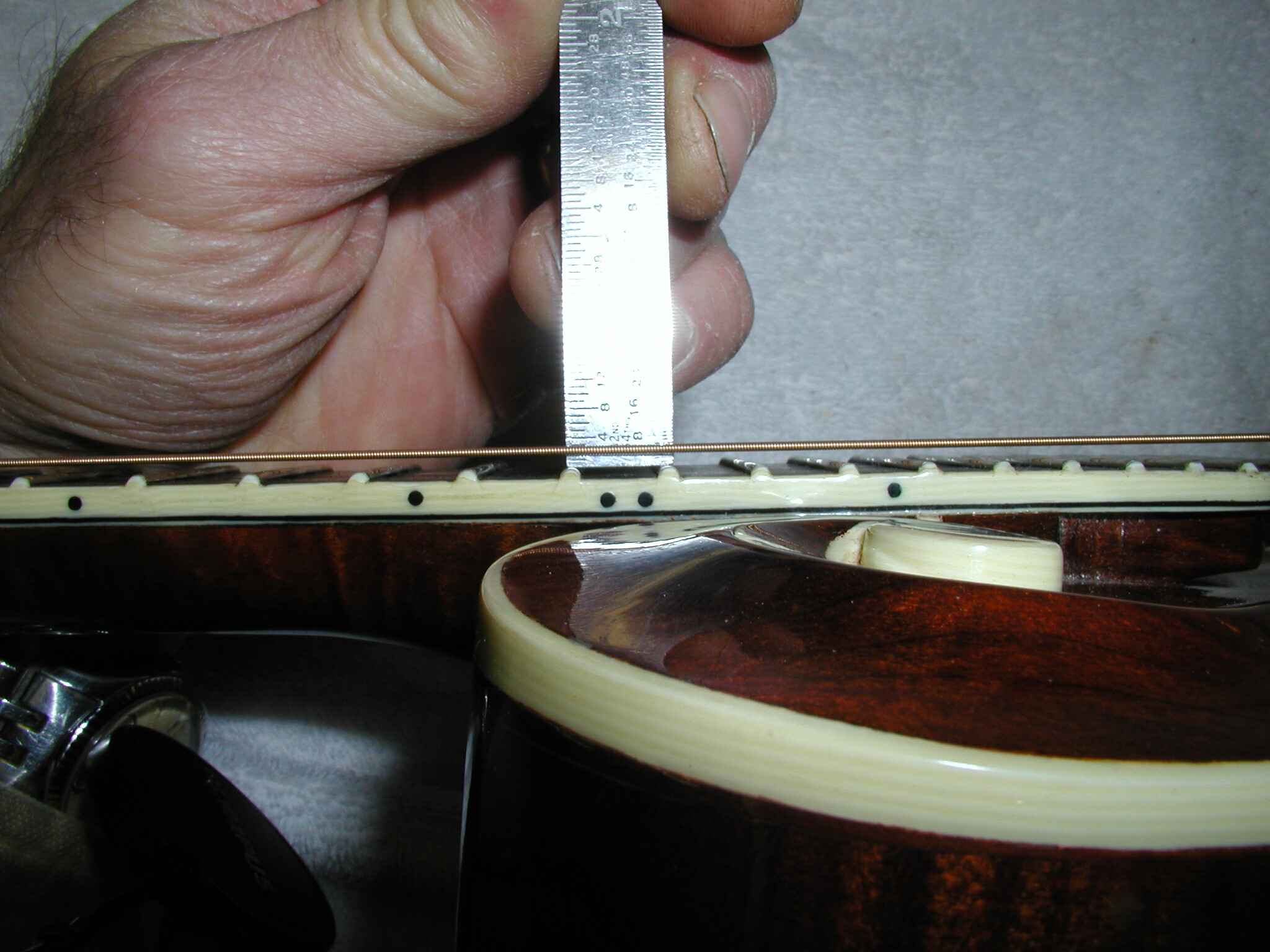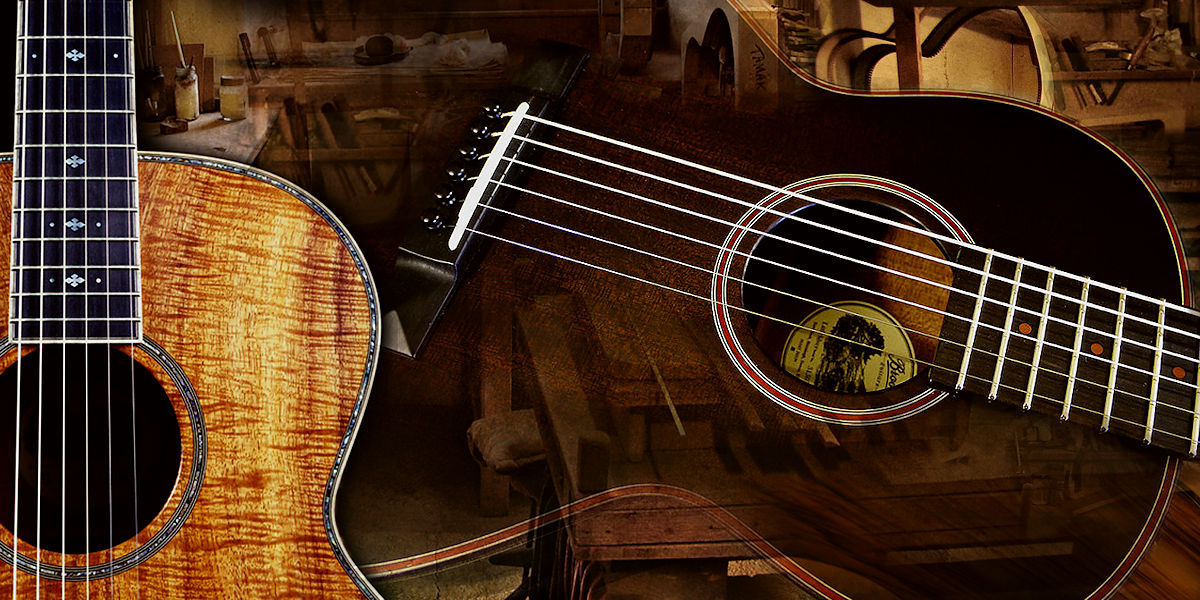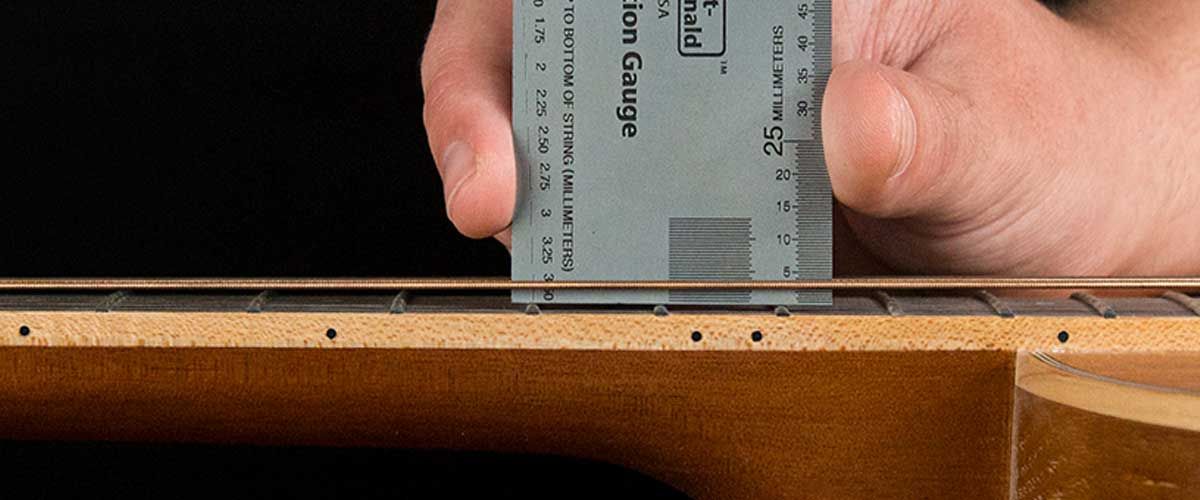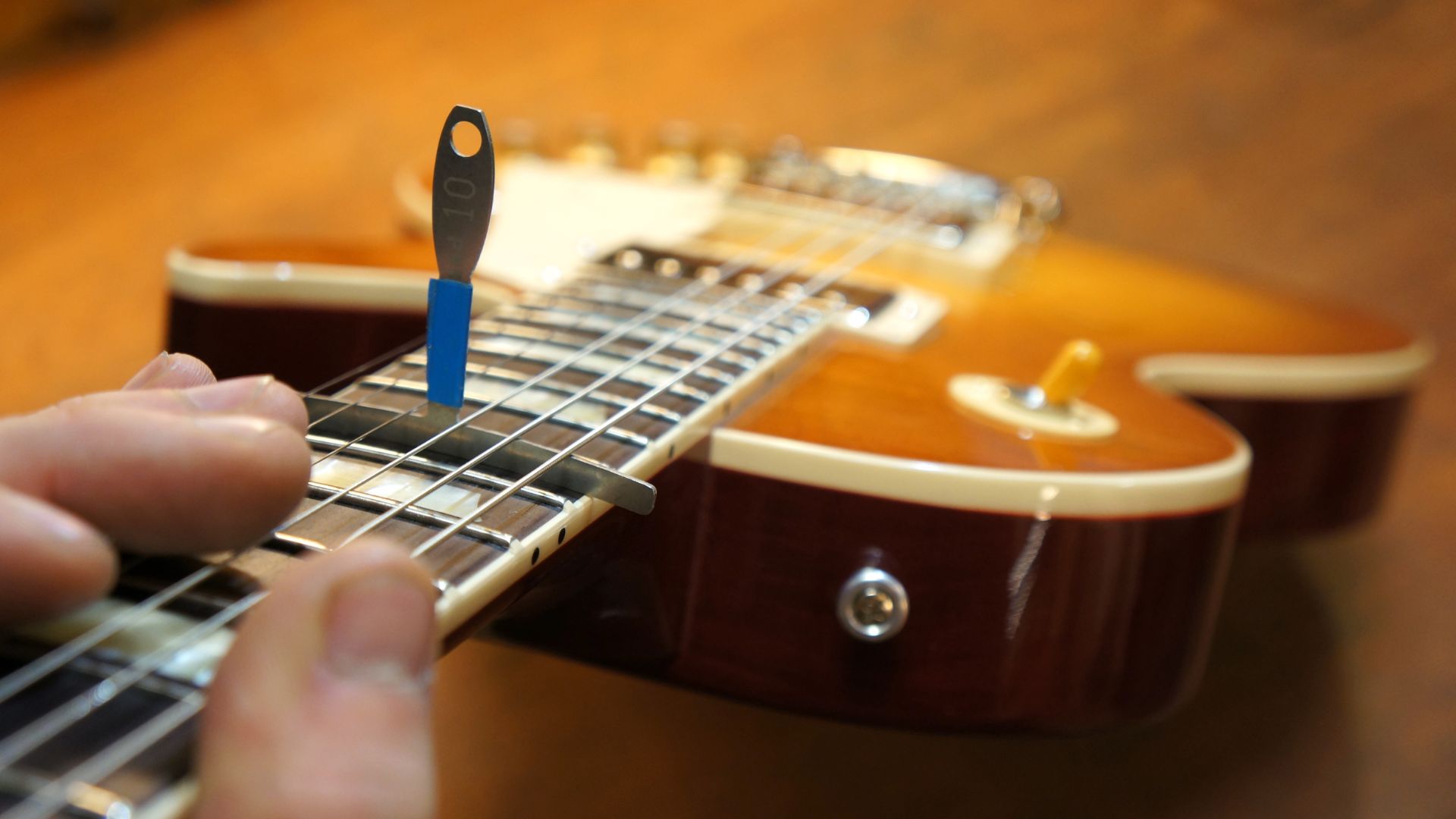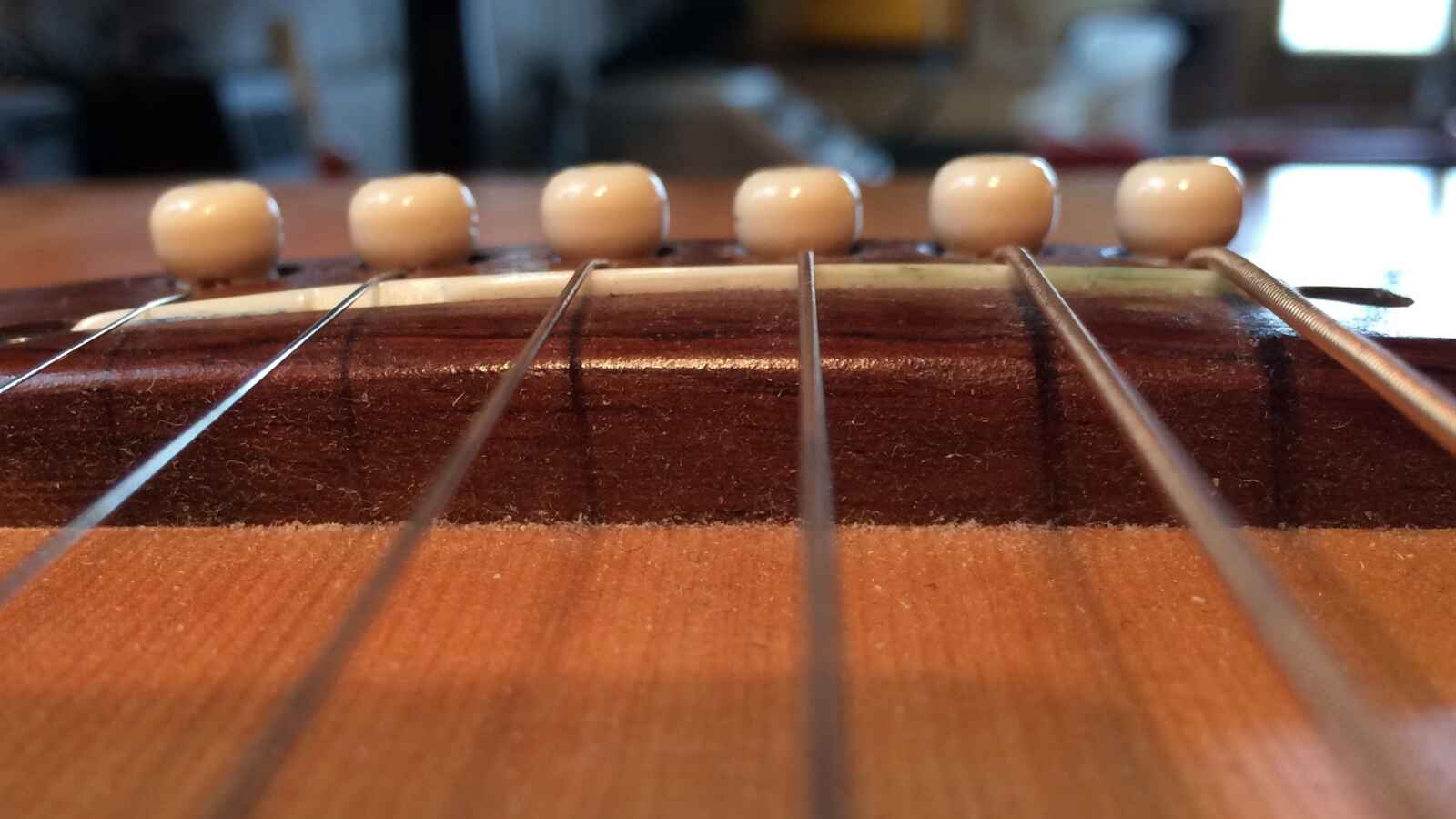Introduction
Welcome to this comprehensive guide on how to make an acoustic guitar saddle. If you’re a guitar enthusiast and want to enhance the sound and playability of your acoustic guitar, replacing the saddle is a fantastic place to start. The saddle plays a crucial role in transmitting vibrations from the strings to the guitar body, ultimately affecting the tone and projection of the instrument.
Many acoustic guitars come with stock saddles that may not be optimized for your specific playing style or desired sound. By making your own acoustic guitar saddle, you have the opportunity to customize the saddle to match your preferences and elevate the overall performance of your guitar.
In this guide, we will take you step-by-step through the process of making an acoustic guitar saddle. We’ll cover everything you need to know, including the different types of saddles, the tools and materials required, and the precise steps involved in shaping, fitting, and installing the new saddle.
Whether you’re an experienced guitar technician or a novice looking to explore the world of guitar maintenance and customization, this guide is packed with valuable information to help you achieve optimal results.
So grab your tools, put on some inspiring music, and let’s dive into the rewarding process of making an acoustic guitar saddle that will enhance the playability and sound of your beloved instrument.
What is an Acoustic Guitar Saddle?
Before we dive into the process of making an acoustic guitar saddle, let’s start by understanding what exactly a saddle is and its importance in the overall performance of an acoustic guitar.
The saddle is a small, rectangular piece located in the bridge of an acoustic guitar. It is typically made of bone, plastic, or other materials that are hard enough to transfer the vibrations from the strings to the guitar’s soundboard effectively. The saddle is positioned perpendicular to the strings and rests on the bridge, determining the height and angle at which the strings are held above the guitar body.
One of the primary functions of the saddle is to transmit the vibrational energy of the strings to the guitar’s soundboard. When a string is plucked, it vibrates, creating sound waves. These vibrations are transferred through the saddle to the bridge and then to the soundboard, causing it to resonate and produce sound.
The saddle also contributes to the intonation of the guitar. Intonation refers to the accuracy of each note when played on different frets. A properly placed and shaped saddle helps to ensure that each string produces the correct pitch when played at different positions on the fretboard.
Furthermore, the saddle directly impacts the action of the guitar. The action refers to the height of the strings above the fretboard. A saddle that is too high can make the strings difficult to press down, affecting playability, while a saddle that is too low can cause buzzing and decreased volume.
In summary, the acoustic guitar saddle is a critical component that influences the sound, intonation, and playability of the instrument. By understanding its role and learning how to make and customize your own saddle, you gain the ability to improve the overall performance and tailor the playing experience to your preferences and style.
Types of Acoustic Guitar Saddles
When it comes to choosing a saddle for your acoustic guitar, there are various options available, each with its own characteristics and advantages. Let’s explore the different types of acoustic guitar saddles:
- Bone: Bone saddles are highly regarded for their excellent tonal qualities. They can enhance the clarity, sustain, and overall resonance of the guitar. Bone saddles are known to produce a balanced and warm tone, making them a popular choice among acoustic guitar players.
- Tusq: Tusq is a synthetic material that aims to replicate the tonal properties of natural materials like ivory or bone. It offers excellent stability, which helps in maintaining accurate intonation and reducing string breakage. Tusq saddles can provide a bright and clear tone, making them suitable for guitars that need a bit of a treble boost.
- Plastic: Plastic saddles are often found on lower-priced guitars. While they may not offer the same tonal characteristics as bone or tusq, plastic saddles can still provide a decent sound and serve their purpose well. They are relatively durable and require less maintenance compared to other types of saddles.
- Micarta: Micarta is another synthetic material used in the construction of guitar saddles. It is a composite of resin and paper that is heat-treated and compressed to create a sturdy and consistent material. Micarta saddles can produce a warm and balanced tone, making them a versatile choice for a wide range of playing styles.
- Wood: Some players prefer wooden saddles for their unique tonal qualities. Different types of wood can provide distinct sonic characteristics, allowing players to customize their tone based on personal preferences. Wood saddles can add warmth, depth, and richness to the guitar’s sound.
It’s important to note that the choice of saddle material can significantly impact the sound and playability of your acoustic guitar. Experimenting with different types of saddles can be a great way to fine-tune your instrument and achieve the desired tonal qualities.
When selecting a saddle, consider factors such as your playing style, the type of guitar you have, and the sound you want to achieve. Ultimately, the right saddle for you will depend on your personal preferences and the specific characteristics you’re seeking from your guitar’s tonal palette.
Tools and Materials You Will Need
Before we jump into the process of making an acoustic guitar saddle, let’s gather the necessary tools and materials you’ll need for this task. Here’s a list of what you’ll need:
- Replacement saddle material: Depending on your preference, you can choose from various materials such as bone, plastic, tusq, micarta, or wood for your new saddle.
- Files: You’ll need a set of files that are suitable for working on small and precise parts. A flat file and various shaping files will be essential for shaping the saddle.
- Sandpaper: Different grits of sandpaper, ranging from coarse to fine, will be necessary for refining the shape and achieving a smooth finish on the saddle.
- Ruler or calipers: Accurate measurements are crucial when making a saddle. A ruler or calipers will help you measure the correct dimensions for your guitar’s saddle slot and ensure an optimal fit.
- Marker or pencil: You’ll need a marker or pencil for marking the saddle slot and guiding your shaping process.
- Masking tape: Using masking tape can help protect your guitar’s bridge while you work on shaping the saddle.
- Small saw or saddle slotting file: If you need to adjust the width or depth of the saddle slot, a small saw or specialized saddle slotting file can be used for this purpose.
- Clamps: Clamps are helpful for securely holding the saddle in place while you shape it. This ensures stability and prevents any accidental movements during the process.
- Adhesive: You’ll need suitable adhesive, such as wood glue or epoxy, to secure the saddle into the saddle slot of the guitar’s bridge.
- Sanding block: A sanding block or a small piece of wood wrapped in sandpaper can be used to achieve a consistent and even sanding surface for the saddle.
Having all these tools and materials ready before you begin will make the process more efficient and ensure that you have everything you need to successfully make and install your new acoustic guitar saddle.
Step 1: Measure and Mark the Saddle Slot
Before you start shaping the new saddle, it’s important to accurately measure and mark the saddle slot on your guitar’s bridge. This will ensure that the saddle fits perfectly and is properly aligned. Here’s how to do it:
- Start by loosening the tension of the strings to make it easier to work on the saddle slot. You can do this by turning the tuning pegs and gradually loosening each string.
- Once the strings are sufficiently loosened, you can remove the old saddle from the bridge. Gently lift it out, taking care not to damage the bridge or the guitar’s top.
- With the old saddle removed, use a ruler or calipers to measure the length, width, and depth of the saddle slot. Take accurate measurements to ensure the new saddle will fit properly.
- Transfer these measurements onto the replacement saddle material using a marker or pencil. Make sure to mark the length, width, and depth of the saddle slot on the material.
- Next, carefully align the replacement saddle material with the existing saddle slot on the bridge of your guitar. Ensure that the marks you made on the material are aligned with the edges of the saddle slot.
- Using the ruler or calipers, double-check the alignment and adjust as necessary. It’s crucial to have the saddle sit flush and straight within the saddle slot.
- Once you’re satisfied with the alignment, mark the exact position of the saddle slot on the replacement saddle material.
- Finally, remove the replacement saddle material from the guitar and use a ruler or straight edge to connect your marks and outline the shape of the saddle. This will serve as a guide for the next steps in shaping the saddle.
By carefully measuring and marking the saddle slot, you ensure that the new saddle will be correctly positioned on the guitar’s bridge. This step is crucial for achieving an accurate fit that will result in optimal playability and sound quality.
Step 2: Remove the Old Saddle
Now that you have measured and marked the saddle slot, it’s time to remove the old saddle from the bridge. Removing the old saddle is a necessary step before you can proceed with shaping and installing the new one. Follow these steps to remove the old saddle:
- Ensure that the guitar strings are still loosened to provide easy access to the saddle.
- Using a small, thin tool such as a thin screwdriver or a saddle puller, gently pry the old saddle out of the saddle slot. Apply gentle pressure to avoid damaging the guitar’s bridge or top.
- If the saddle is tightly wedged and difficult to remove, you can use the end of a small saw or a specialized saddle slotting file to carefully loosen it. Insert the tool into the slot and gently twist or move it side to side to free the saddle.
- Once the old saddle is loose, you should be able to lift it out completely from the saddle slot. Take care not to scratch or damage the guitar’s bridge during this process.
- Inspect the saddle slot for any debris or old adhesive residue. Clean the slot thoroughly using a soft brush or cloth to ensure a clean surface for the new saddle.
- At this point, it’s a good idea to assess the condition of the saddle. If the old saddle is still in good shape and you plan to reuse it, set it aside in a safe place. Otherwise, if the saddle is worn or damaged, it’s recommended to replace it with a new one.
By carefully removing the old saddle, you prepare the guitar’s bridge for the installation of the new saddle. It’s important to handle the removal process with care to avoid any damage to the guitar and ensure a smooth transition to the next steps of the saddle replacement process.
Step 3: Prepare Your New Saddle Material
With the old saddle removed, it’s time to prepare your new saddle material for shaping and fitting. Properly preparing the new saddle material is crucial to ensure optimal performance and a superior fit. Follow these steps to prepare your new saddle material:
- Start by carefully inspecting the new saddle material for any imperfections or irregularities. Ensure that it’s free from cracks, chips, or any other structural issues that may affect its durability or performance.
- If necessary, use a small file or sandpaper to smooth any rough edges or surfaces on the new saddle material. This will make it easier to work with when shaping and fitting the saddle.
- If your new saddle material is made of bone or similar natural materials, it’s a good practice to soak it in warm water for a few minutes. This will help soften the material and make it more pliable during the shaping process.
- Once the new saddle material has been soaked or if it’s a synthetic material like plastic or tusq, wipe it with a clean cloth to remove any excess moisture.
- Next, double-check the measurements and marks you made earlier on the saddle material, ensuring that they are still visible and accurate.
- Using a pencil or marker, mark the parts of the saddle material that need to be removed or shaped based on your guitar’s specific requirements. This can include marking the height, length, and any other dimensions necessary for achieving the desired saddle shape.
- Secure the new saddle material in a vise or clamp that will allow you to work on it comfortably and safely. Ensure that it’s firmly held in place to prevent any movement during the shaping process.
- At this point, you’re ready to move on to the next step of shaping the saddle. Having the new saddle material properly prepared and marked will make the shaping process more precise and efficient.
By carefully preparing your new saddle material before shaping, you ensure a solid foundation for achieving the desired shape and fit. Taking these steps will result in a well-prepared and finely shaped saddle that contributes to the overall performance and playability of your acoustic guitar.
Step 4: Shape the Saddle
Now that you have prepared your new saddle material, it’s time to shape it to fit your guitar. Shaping the saddle is a critical step as it directly affects the intonation, action, and overall playability of the instrument. Follow these steps to shape the saddle:
- Referencing your marked dimensions and guidelines, begin shaping the saddle material using suitable shaping files. Start by removing excess material from the sides, carefully working towards the marked outline.
- As you shape the saddle, keep checking the fit by placing it back into the saddle slot of the guitar’s bridge. Make sure it sits flush and securely within the slot without any gaps.
- Continue refining the shape, paying close attention to the height and overall curvature of the saddle. Use a combination of filing and sanding to achieve the desired shape and smoothness.
- Focus on shaping the top of the saddle, which comes into direct contact with the strings. It’s crucial to create a flat and even surface to ensure proper string alignment and promote clean intonation.
- Check the action by temporarily placing the saddle in the bridge and comparing the height of the strings above the fretboard. Make any necessary adjustments to achieve the desired string height for comfortable playing.
- Throughout the shaping process, periodically check the overall fit and alignment of the saddle within the saddle slot. Ensure that it sits securely and evenly, maintaining proper contact with the bridge.
- Once you are satisfied with the shape and fit of the saddle, use fine-grit sandpaper to smooth any rough edges or surfaces. This will create a polished finish and ensure a comfortable playing experience.
Remember to work gradually and make small adjustments to avoid removing too much material at once. It’s better to take your time and approach the shaping process with precision and patience. By carefully shaping the saddle, you’ll achieve optimal string height, intonation, and playability for your acoustic guitar.
Step 5: Fine-tune the Height and Fit
After shaping the saddle to its rough form, it’s time to fine-tune the height and fit of the saddle. This step ensures optimal string action and a comfortable playing experience. Follow these steps to fine-tune the height and fit of the saddle:
- With the saddle shaped and smoothed, temporarily place it back into the saddle slot of the guitar’s bridge.
- Assess the string height by comparing it to the fretboard. The action should be set to your preference, allowing for comfortable fretting and minimal string buzzing.
- If the action is too high, carefully remove the saddle and use a file or sandpaper to reduce its height. Make small adjustments at a time, checking the string height frequently to avoid removing too much material.
- Conversely, if the action is too low and causing string buzzing, you can add a shim to raise the saddle. A shim can be made from a thin piece of material such as a business card or veneer. Place it under the saddle to increase its height and adjust the action.
- Continuously check the height and fit of the saddle, making fine adjustments as needed until you achieve the desired action and playability.
- Ensure that the saddle sits securely and evenly within the saddle slot, maintaining proper contact with the bridge. Any gaps or instability may affect tone and sustain.
- Once you are satisfied with the height and fit of the saddle, remove it from the guitar and set it aside for the final installation.
The process of fine-tuning the height and fit of the saddle is crucial to achieving optimal playability and ensuring the strings are at an ideal height above the fretboard. This step allows you to personalize the action to your preferences, optimizing the overall performance of your acoustic guitar.
Step 6: Install the New Saddle
Now that you have shaped and fine-tuned the new saddle to achieve the desired height and fit, it’s time to proceed with installing it in the saddle slot of your guitar’s bridge. Follow these steps to install the new saddle:
- Apply a thin layer of adhesive, such as wood glue or epoxy, to the bottom of the new saddle. Ensure that the adhesive is evenly spread and covers the entire bottom surface.
- Place the new saddle into the saddle slot, aligning it carefully with the markings and the slot itself.
- Press the saddle gently but firmly into the slot, ensuring a secure fit. Clean off any excess adhesive that may have squeezed out during the installation process.
- Double-check the alignment and height of the saddle, adjusting if necessary to achieve the desired action and proper string-to-fret clearance.
- Allow the adhesive to dry according to the manufacturer’s instructions. Avoid placing any tension on the strings during this time to prevent any movement or shifting of the saddle.
- Once the adhesive is completely dry, typically after a few hours or overnight, you can restring your guitar and tune it to your desired pitch.
- Check the saddle’s fit and stability after restringing, ensuring that it sits securely in the saddle slot and remains properly aligned.
- Play the guitar and listen for any abnormal vibrations or buzzing. Make any necessary adjustments to the saddle’s height or fit to achieve optimal tone, playability, and sustain.
Installing the new saddle completes the process of replacing the old one, allowing you to enjoy the improved playability and sound of your acoustic guitar. Take care to ensure a secure fit and strong bond between the saddle and the bridge for long-lasting performance.
Step 7: Test and Adjust the Action
With the new saddle installed, the final step is to test and adjust the action of your acoustic guitar. The action refers to the height of the strings above the fretboard, and it greatly affects playability and overall performance. Follow these steps to test and adjust the action:
- Tune your guitar to the desired pitch and ensure the strings are properly stretched.
- Play each string open and fretted at different positions along the neck. Listen for any buzzing or unwanted rattling sounds.
- If you encounter buzzing, particularly when playing open or fretted notes, it indicates that the action is too low. In this case, you may need to adjust the height of the saddle slightly.
- To raise the action, carefully remove the saddle from the guitar and use a file or sandpaper to remove a small amount of material from the bottom of the saddle. Repeat this process incrementally until the buzzing is eliminated.
- If you find that the action is too high, causing difficulty in fretting notes or excessive string tension, you can lower the saddle. Sanding the bottom of the saddle evenly and gradually will reduce the height and improve playability.
- After making any adjustments to the saddle, re-install it in the saddle slot and restring the guitar.
- Test the action again by playing various notes and chords. Continue adjusting the saddle height accordingly to achieve a comfortable and buzz-free playing experience.
- Make sure to fine-tune the action of each string individually, providing consistent string height across the fretboard.
Testing and adjusting the action is an important step in the saddle replacement process. It ensures that the strings are at an optimal height, allowing for easy playability and clear, buzz-free notes. Take your time during this step to achieve the best action for your playing style and preference.
Conclusion
Congratulations! You have successfully learned how to make an acoustic guitar saddle. By following the steps in this guide, you have taken a significant step towards improving the playability, tone, and overall performance of your acoustic guitar.
The saddle plays a critical role in transmitting the vibrations from the strings to the guitar body, affecting the tone, intonation, and action of the instrument. By customizing and shaping your own saddle, you have the opportunity to tailor these elements to your preferences and achieve the desired sound and playability.
Throughout the process, you have learned how to measure and mark the saddle slot, remove the old saddle, prepare the new saddle material, shape the saddle, fine-tune the height and fit, install the new saddle, and test and adjust the action. Each step contributes to a precise and well-fitted saddle that enhances your guitar playing experience.
Remember to take your time during each stage, ensuring accuracy and precision. It’s important to make small adjustments and continuously evaluate the fit and performance of the saddle as you progress through the steps.
Now that you have successfully installed your new saddle, take some time to play your guitar and assess the results. Listen for the improved tone, sustain, and playability. If needed, make any final adjustments to achieve the ideal action and perfect your guitar’s setup.
Keep in mind that the saddle is just one element that contributes to the overall sound and performance of your guitar. Other factors such as the strings, nut, and overall setup also play important roles. Therefore, it’s worth considering a complete setup or consulting a professional guitar technician to optimize your instrument’s performance.
Enjoy the journey of guitar customization and maintenance. Armed with the knowledge of how to make an acoustic guitar saddle, you can now explore different materials, experiment with shaping and fine-tuning techniques, and further enhance your guitar’s unique characteristics.
Happy playing!







